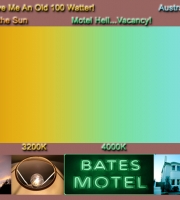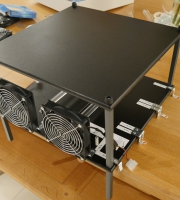


At this stage of the test, we have reached a plateau because conditions only require these two limiters to be active and Furmark is a synthetic benchmark that has placed a fixed load on the GPU, as opposed to a game that might bring about a sudden, heavy demand immediately after loading a new level, or when the screen is densely and sparsely populated over short, intensive periods of emphatic enemy evisceration.
Now, let’s see what happens when we implement a significant change and hopefully, force the next paratrooper to perform his party piece. On the Afterburner control panel, there is a small arrow entitled “Prioritize” residing between the sliders for power and temperature limit. Presently, it is pointing upwards, towards the value that declares the card’s power target, currently set at 100%.
This means when under pressure, the GPU is giving priority to regulating its energy demands in compliance with the TDPs limit of 250 watts and ignoring its thermal threshold of 80 degrees, considered the card’s “safe default”, in doing so. As things stand, only when it reaches its definitive perimeter of 95 degrees, will the temperature limiter be called into play. So far, as we’ve seen, this has not occurred.
But with one click, we can force our temperature target of 80 degrees to be the Titan’s raison d’etre and as a result, re-prioritize the temperature and power limiters.
Here we go….
As expected, we witness the “temperature limiter” – fifth line down – willingly surge into life, relieving the power and utilization limiters of their posts and standing stoically as it attempts to meet our request. Core and memory speeds are concurrently and severely throttled as another effective means of minimizing heat, the GPU’s power draw drops dramatically to below 50% and the usage trace exhibits troughs deeper than the Marajana trench.
In contrast to the previous scenario, where two limiters were engaged with individual tasks, we now have one limiter invoking changes on three, albeit with two fleeting interventions from utilization limiter. In short order, the temperature levels off at 80 degrees.
The term “temp limit” in this context is a little misleading since changes in temperature are being affected by a heat or energy source. Your saucepan of hot, creamy porridge won’t cease bubbling unless you turn that fiery Aga down a few notches. When you do, you are limiting power in order to reduce temperature as opposed to lowering temperature directly. Essentially, this is another form of voltage limitation and ought to be labelled as such.
What if you blew on the porridge, wouldn’t that directly lower the temperature?
Yes Mr. Forum expert, I did say “in this context”.
The “Voltage Limiter” is also deceptively defined since it does not represent the imposition of a safety measure but instead illustrates when the card is receiving the most pronounced injection of pace permitted by GPU boost. In other words, it denotes when catalysts and workloads are comprehensively favourable and all pipelines are firing in fearful frame fracturing ferocity. Like the Utilization limiter, its presence was predicated on the card’s prescribed parameters. Hence, the reason why it was never active on this occasion, was because Furmark instantly expended every available watt and precipitated conditions that were too hot for the maximum boost bin to be authorized.
Coercing the final limiter into action was a task too tough. Tempting fate a tad, I raised the Titan’s power limit from its default of 250W to 265W TDP (106%), but all this achieved was to delegate control back to the power and utilization limiters” neither of which yielded to any except each other, despite restarting the benchmark multiple times. I could spend hours, days, or however long it takes for my regal rendering Romeos to frizzle and fry into ROP shot relics putting my mind to this mystery but would far rather leave such dangerous dicing to those who axe X-boxes, pulverize Playstations, trample tablets, incinerate iphones and amass more Youtube hits in a week than I shall in a hundred lifetimes.
Best guess? Since the Titan’s indigenous survival instincts ultimately depend on its TDP, it would be logical to assume the abbreviation “OV MAX” refers to the proverbial General, the “Chief Sentinel” or “None Shall Pass Bridge Troll”. Of course, we must be mindful that all this data originates from third party software and precisely what each of these values, legends and labels, especially the limiters, correspond to on the card in real hardware terms is virtually impossible to ascertain….at least…it was in my case
But hankering back to useful knowledge and the joys of clarity, does it really matter?
The reducing of degrees by the lessening of watts and the throttling of clocks.
Heat=Bad. Result=Potentially shorter lifespan for GPU.
Mission=Make GPU run cooler.
Solutions.
Increase the Fan speed.
Reduce the clock speed.
Reduce the power itself.
Examples.
Note that the descriptions refer to each card’s definitive safety measures, the post it will flat out refuse to abandon in approval of its master’s avarice, irrespective of all other variables. In the Titan’s case, there are two “non-negotiable clauses”, its thermal tolerance of 95 degrees and TDP of 265W and as we have witnessed, the protocols to preserve them are swift and decisive.
Wait a moment….cry the tweakers in uncompromising unison.
Temperature is ultimately subordinate to power, it depends on energy, it can be forced to diminish faster, made to radiate efficiently. What if I pacified my pipeline worn primate with the milk of human kindness…..WATER! Perimeters would be safe, those “temperature rovers” would stay submerged, permanently poised on “orange” alert. Shaders could shine, Cuda’s would crunch, Fahrenheit need no longer foil my quest for fame and frames.
Well, when stranded in the sands of gruelling gaming, febrile folding and murderous mining, it would indeed be far simpler to dial away your dearth of degrees than casually cruise over your allotted wattage. There are astrophysical equations, described as “beautiful” in the mellifluous Mancunian musings of Brian Cox that solidly prove the reflective tendencies of power and heat as each rises and falls. However, under these circumstances, to guarantee a correlation consistent enough to afford a credible advantage would be to invent a way of controlling the weather or of making a gas bill a riveting read.